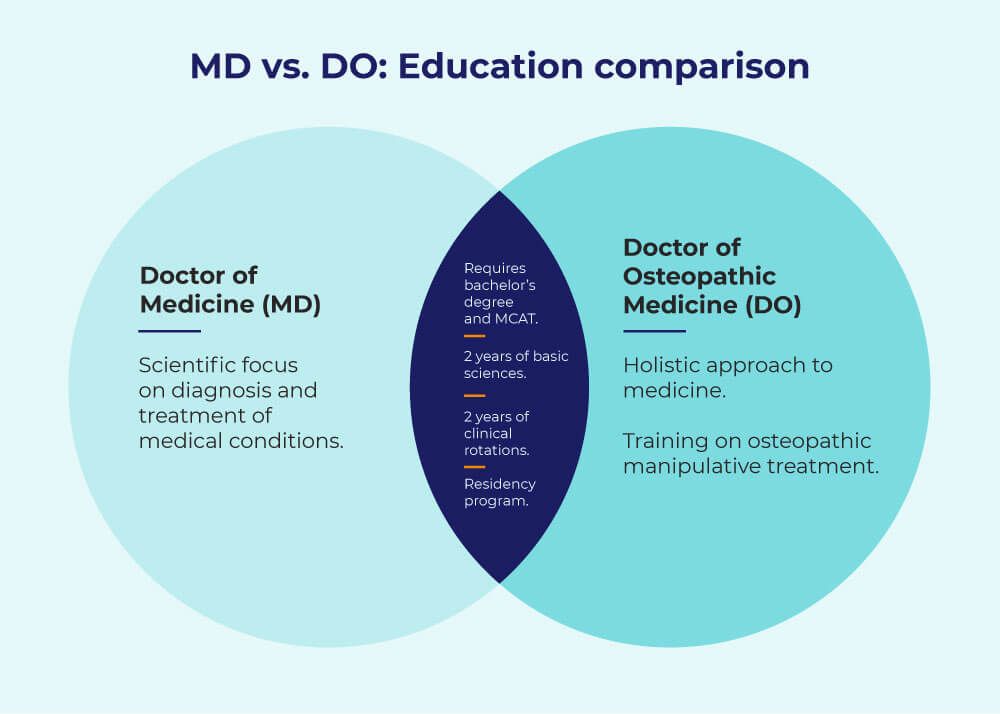There are more than a hundred medical specialties out there and multiple different degrees associated with the field of medicine. The terms “doctor” and “MD” are often used interchangeably, when in reality, this isn’t entirely accurate. The truth is that licensed physicians can have either a DO (doctors of osteopathic medicine) or an MD degree.
MD and DO degrees have as many similarities as they have differences. We put together this comprehensive comparison to help you determine which program best fits your unique goals and priorities.
Allopathic vs. Osteopathic: Two different philosophies
Allopathic (MD) and osteopathic (DO) medical schools both teach students the scientific foundations needed to become licensed physicians, but they take different approaches. Most people are familiar with allopathic medicine, a science-based practice focused on diagnosing and treating medical conditions.
Some people ultimately choose to pursue allopathic medicine because it’s the only type they know, which was the case for SGU graduate Dr. Benjamin Stueben, a pathologist and researcher. “To be honest, my dad’s side of the family were mostly MDs, so I didn’t put any thought into going for a different degree,” he explains. “In fact, I didn’t really learn what a DO was until I had already started medical school.”
There’s clearly a difference between MD and DO philosophies, so what is a DO, exactly? Osteopathic medicine takes a more holistic approach and focuses heavily on prevention. DOs also learn osteopathic manipulative treatment (OMT), a hands-on method that involves moving muscles and joints in a way designed to promote healing.
“In osteopathic medical school, we learned that the patient is a whole unit and not just individual parts,” says Dr. Jill Garripoli Pedalino, a pediatrician and owner of Healthy Kids Pediatrics. This whole-body approach is often one of the biggest reasons an individual ends up choosing to become a DO.

MD vs. DO: Medical school
Getting into medical school takes hard work, and that goes for both DO and MD programs. Both a solid GPA and MCAT score are important. According to the Association of American Medical Colleges, applicants who were accepted to allopathic medical schools for the 2018–19 school year averaged 511.2 on the MCAT and had a 3.72 GPA average.
The American Association of Colleges of Osteopathic Medicine breaks down GPA figures for varying levels of education, but those going from a bachelor’s program to medical school averaged a 3.54. The mean MCAT score for applicants who were accepted into a DO program was 503.8.
Both osteopathic and allopathic medical school programs typically last four years and include medical science coursework as well as clinical rotations. What really sets DO school apart is the training focused on OMT. Most programs require at least 200 hours dedicated to this hands-on technique.
Dr. Garripoli says these techniques help students in DO school understand how the body operates as a whole. “We learned that the body is completely interconnected and that there are manual techniques to help a person restore their optimal health,” she explains.
There’s some debate about whether these manipulative techniques are truly beneficial. Skeptics point to research suggesting results are inconclusive. On the other hand, there are studies indicating this type of hands-on treatment can be effective. One example is a recent review that found premature babies experienced shorter hospital stays when OMT was used.
MD vs. DO: Residency and licensing exams
Getting into medical school takes hard work, and that goes for both DO and MD programs. Both a solid GPA and MCAT score are important, and applicants take this seriously.
- MD program applicants averaged 506 on the MCAT and had a 3.6 GPA average
- DO program applicants average 503 on the MCAT and has a 3.5 GPA
Both osteopathic and allopathic medical school programs typically last four years and include medical science coursework as well as clinical rotations.
What really sets DO school apart is the training focused on OMT. Most programs require at least 200 hours dedicated to this hands-on technique. Dr. Garripoli Pedalino says these techniques help students in DO school understand how the body operates as a whole. “We learned that the body is completely interconnected and that there are manual techniques to help a person restore their optimal health,” she explains.

MD vs. DO: Residency and licensing exams
The real distinction of DO versus MD used to be most apparent when it came to residency and licensing exams, but even this has changed. It once was the case that students at allopathic schools would take the United States Medical Licensing Exam (USMLE) series and osteopathic students would take the Comprehensive Osteopathic Medical Licensing Exam ( COMLEX) sequence to apply to their respective residency programs.
A recent move to a single graduate medical education accreditation system has changed this system. Osteopathic and allopathic medical students now have access to the same pool of residency programs—though some choose to maintain Osteopathic Recognition—and both types of licensing exam series are equally recognized.
In 2020, students used the National Resident Matching Program to be matched to one of their preferred residencies. Results show that:
- Allopathic students and graduates had a match rate of 90.2%.
- Osteopathic students and graduates had a match rate of 86.9%.
MD vs. DO: Salary and career outlook
You may be wondering whether there’s a pay difference between MD and DO degrees. You really aren’t going to find a difference in comparing an osteopathic doctor’s salary to an allopathic doctor’s salary. Earning potential actually doesn’t depend on the degree as much as the medical specialty you choose to pursue.
In general, DOs tend to pursue primary care specialties more often than MDs. According to the American Medical Association (AMA), nearly 57 percent of DOs were practicing in primary care specialties in 2019 compared to less than 30 percent of MDs. That said, both types of physicians can be found practicing in every medical specialty.
What degree path should you follow?
You are now equipped with some important information to help you decide between MD versus DO programs, but Dr. Stueben has one more word of wisdom. “For those deciding between MD or DO programs, I’d apply to both and base your decision not on the degree, but on all the other factors that go into choosing a school,” he advises.
Because there are so many things to consider when deciding which school to attend, you’ll want to do your research. Learn more about how to critically compare programs by reading, “How to Choose a Medical School: 9 Things to Evaluate Before Accepting.”. You can also register for an SGU Virtual Information Session to learn more.
*This article was originally published in December 2017. It’s since been updated to reflect information relevant to 2024.


